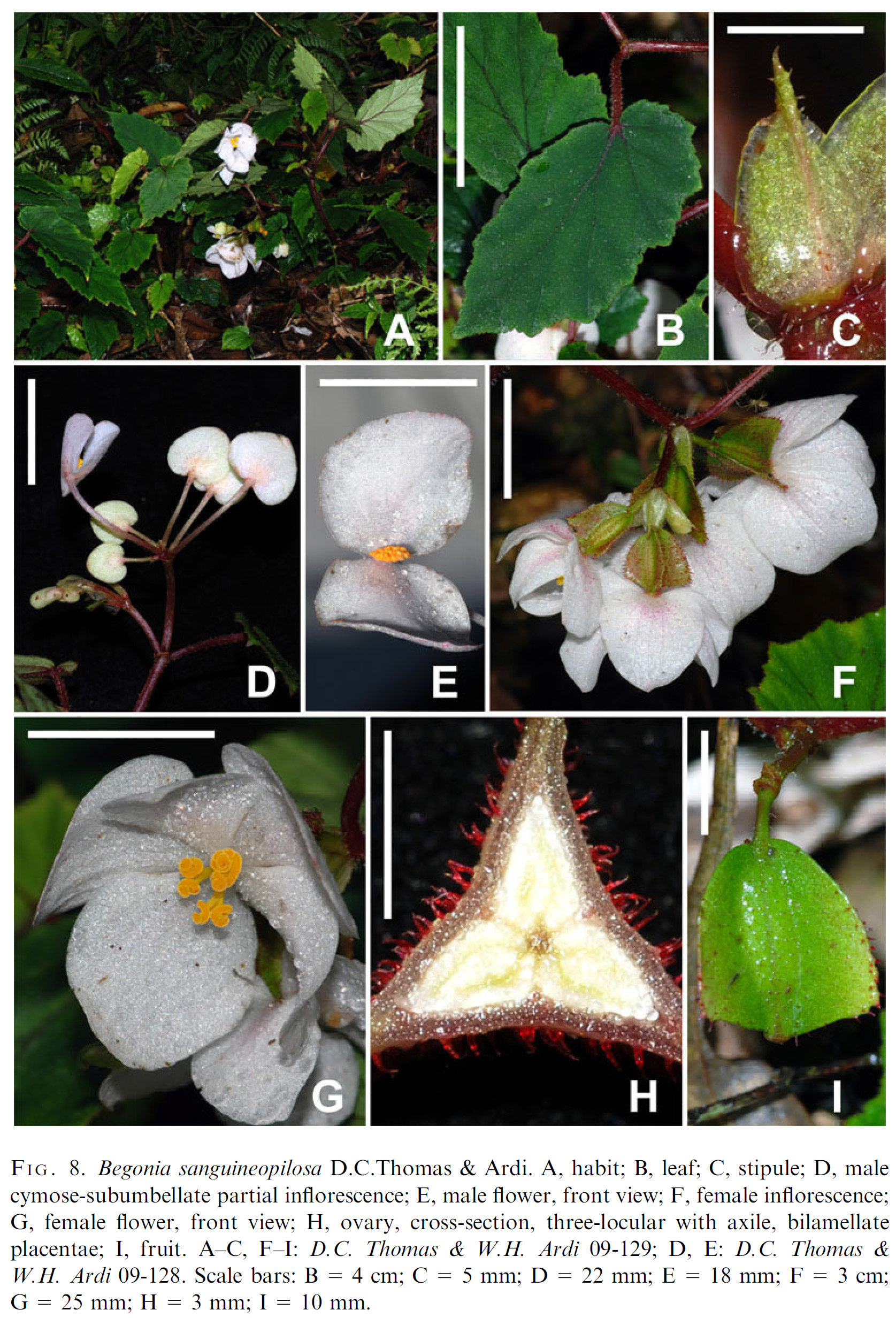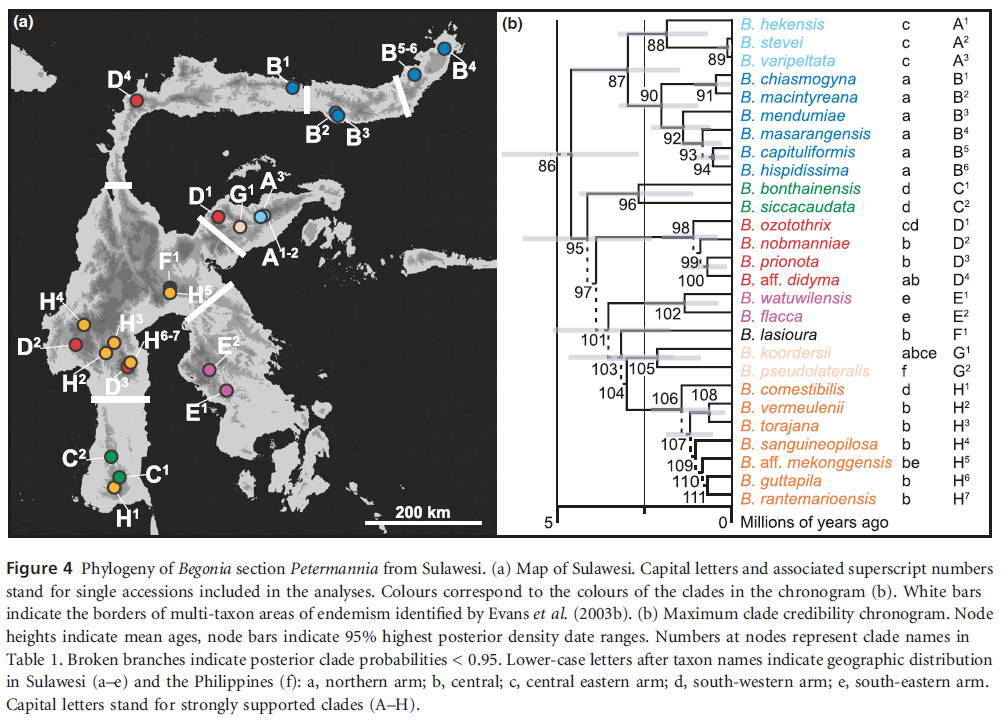Begonia sanguineopilosa in Edinburgh J. Bot. 68(2): 243. 2011
Primary tabs

Diagnosis
- Begoniae celebicae Irmsch. similis a qua pedicellis florum masculorum longioribus (18-32 mm longis nec c.15 mm), tepalis florum masculorum multo longoribus (18-32 mm longis nec c.9 mm) et tepalis florum femineorum multo longoribus (15-32 mm longis nec c.11-12 mm) differt. - Type: Indonesia, Sulawesi, Sulawesi Barat, Gunung Mambulinin, 02°53'42.5S, 119°21'37.6E, 1856 m, 11 v 2009, D.C. Thomas & W.H. Ardi 09-129 (holo E; iso BO, L). (Thomas, D.C., Ardi, W.H. & Hughes, M., Nine new species of Begonia (Begoniaceae) from South and West Sulawesi, Indonesia in Edinburgh Journal of Botany 68(2). 2011)
Description
- Perennial, dioecious? herb, with erect stems, to c.40 cm tall, with a sparse indumentum of microscopic, glandular trichomes and multicellular, simple trichomes up to c.1.2 mm long on all above-ground vegetative parts.
Stems branched; internodes c.2-10.5 cm long, reddish to brownish.
Leaves alternate; stipules caducous, 8-15 × 3-8 mm, ovate, elliptic or oblong, with an abaxially prominent midrib that projects shortly at the apex; petioles 3-6 cm long, reddish; lamina 5.5-12 × 2-5 cm, basifixed, very asymmetric, ovate, elliptic or oblong, base cordate and lobes not overlapping, apex acuminate, margin biserrate to slightly lobed (up to c.20% of the lamina width), scalloped, teeth not or shortly bristle-pointed, adaxial surface dark green and abaxial surface pale green, primary veins 2-4, subpinnate, secondary veins craspedodromous.
Inflorescences: female inflorescences 2-flowered, with 1-2 partial inflorescences at subsequent nodes, peduncles c.1 mm long; male inflorescen- ces composed of 1-3 cymose-subumbellate partial inflorescences, each with 1-3 compressed monochasia with 1-3 flowers, peduncles 5-23 mm long.
Male flowers: pedicels c.18-32 mm long; tepals 2, white or whitish tinged with pink, 13-19 × 14-19 mm, broadly ovate to suborbicular, base cordate, apex rounded, abaxially with a sparse indumentum of multicellular, reddish hairs and microscopic glandular hairs; androecium of c.32-48 stamens, yellow, filaments up to c.2 mm long, slightly fused at the base, anthers c.1-1.2 mm long, obovate, dehiscing through unilaterally posi- tioned slits that are > 1/2 as long as the anther.
Female flowers: pedicels 4-13 mm long; tepals 5, white or white tinged with pink, subequal, 15-32 × 9-29 mm, broadly ovate, elliptic or suborbicular, abaxially with a sparse indumentum of multicellular, reddish hairs and microscopic glandular hairs; ovary ellipsoid, moderately densely hairy, locules 3, placentation axile, placentae bilamellate, wings 3, triangular, subequal, base rounded, apex rounded or truncate, 2-9 mm at the widest point (at the apex or in the upper third of the ovary), style basally shortly fused, 3-branched, each stylodium bifurcate in the stigmatic region, stigmatic surface a spirally twisted papillose band, yellow.
Fruiting pedicels up to c.13 mm long. Fruits semi-fleshy, ellipsoid, c.18 × 6 mm (excluding the wings), moderately hairy to glabrescent, indehiscent?, wing shape as for ovary, up to 10 mm wide at the widest point; seeds ellipsoidal, c.0.3 mm long, collar cells c.1/2-2/3 of the length of the seed. (Thomas, D.C., Ardi, W.H. & Hughes, M., Nine new species of Begonia (Begoniaceae) from South and West Sulawesi, Indonesia in Edinburgh Journal of Botany 68(2). 2011)
Habitat
- This is a rainforest floor species observed on steep slopes between c.1800 and 2100 m above sea level.
Conservation
- Proposed IUCN conservation category: Vulnerable (VU D2). Large areas of Mamasa valley have been deforested to make way for settlements and the cultivation of rice and other crops. Coffee plantations and logged areas reach up to almost 2000 m above sea level on the southwestern flank of Gunung Mambulinin. These completely converted areas border the locality of Begonia sanguineopilosa, which is in an area which has no legally protected status. All available Begonia specimens from A, B, BM, BO, CEB, E, K, L, SING and WAG have been consulted, and hence it must be assumed that Begonia sanguineopilosa has a very restricted range. However, further exploration of the largely unexplored and extensive rainforests of the Quarles Mountain Range are needed to confirm whether Begonia sanguineopilosa is a rare local endemic or shows a wider distribution. We adopt a cautionary approach here, as the existing data indicate that Begonia sanguineopilosa is "prone to the effects of human activities or stochastic events within a very short time period in an uncertain future" (IUCN, 2001). (Thomas, D.C., Ardi, W.H. & Hughes, M., Nine new species of Begonia (Begoniaceae) from South and West Sulawesi, Indonesia in Edinburgh Journal of Botany 68(2). 2011)
Distribution
Asia-Tropical: Sulawesi (Sulawesi endemic)
Endemic to Indonesia, Sulawesi, West Sulawesi.
See Images for a distribution map, and specimen tab for map of point distribution data of georeferenced specimens.
See Images for a distribution map, and specimen tab for map of point distribution data of georeferenced specimens.
Etymology
- The specific epithet is a compound of sanguineus (Latin - blood-red) and pilosus (Latin - hairy). It refers to the red indumentum of the ovary and the abaxial surfaces of the tepals.
Notes
- Begonia sanguineopilosa belongs to a group of closely related species which are characterised by putative dioecy, fleshy or semi-fleshy fruits, and succulent, leathery leaves (see notes under Begonia rantemarioensis). Within this group Begonia sanguineopilosa is distinct because of the relatively narrow leaves with a subpinnate venation, the large tepals of the female flowers, as well as the reddish indumentum on the ovary and the abaxial tepal surfaces. (Thomas, D.C., Ardi, W.H. & Hughes, M., Nine new species of Begonia (Begoniaceae) from South and West Sulawesi, Indonesia in Edinburgh Journal of Botany 68(2). 2011)
Molecular Systematics
- see Thomas et al., 2012 (Thomas, D.C., Hughes, M., Phutthai, T., Ardi, W.H., Rajbhandary, S., Rubite, R., Twyford, A.D. & Richardson, J.E. 2012: West to east dispersal and subsequent rapid diversification of the mega-diverse genus Begonia (Begoniaceae) in the Malesian archipelago. – Journal of Biogeography 39: 98-113)
- GenBank
 |


